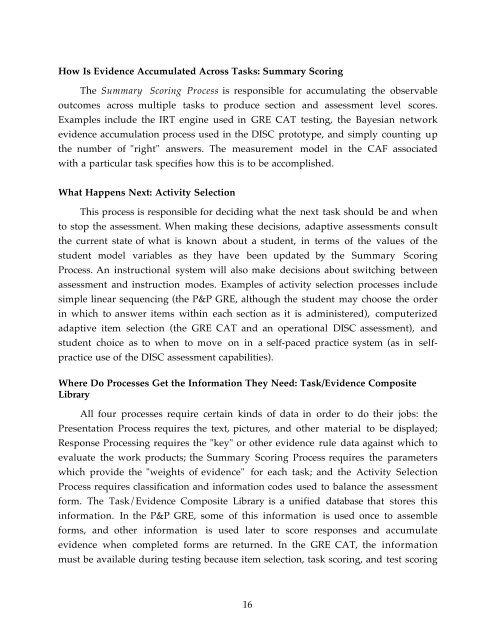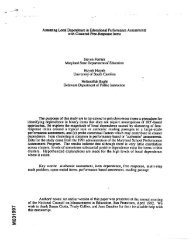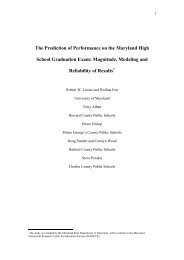A Brief Introduction to Evidence-Centered Design CSE Report 632 ...
A Brief Introduction to Evidence-Centered Design CSE Report 632 ...
A Brief Introduction to Evidence-Centered Design CSE Report 632 ...
Create successful ePaper yourself
Turn your PDF publications into a flip-book with our unique Google optimized e-Paper software.
How Is <strong>Evidence</strong> Accumulated Across Tasks: Summary ScoringThe Summary Scoring Process is responsible for accumulating the observableoutcomes across multiple tasks <strong>to</strong> produce section and assessment level scores.Examples include the IRT engine used in GRE CAT testing, the Bayesian networkevidence accumulation process used in the DISC pro<strong>to</strong>type, and simply counting upthe number of "right" answers. The measurement model in the CAF associatedwith a particular task specifies how this is <strong>to</strong> be accomplished.What Happens Next: Activity SelectionThis process is responsible for deciding what the next task should be and when<strong>to</strong> s<strong>to</strong>p the assessment. When making these decisions, adaptive assessments consultthe current state of what is known about a student, in terms of the values of thestudent model variables as they have been updated by the Summary ScoringProcess. An instructional system will also make decisions about switching betweenassessment and instruction modes. Examples of activity selection processes includesimple linear sequencing (the P&P GRE, although the student may choose the orderin which <strong>to</strong> answer items within each section as it is administered), computerizedadaptive item selection (the GRE CAT and an operational DISC assessment), andstudent choice as <strong>to</strong> when <strong>to</strong> move on in a self-paced practice system (as in selfpracticeuse of the DISC assessment capabilities).Where Do Processes Get the Information They Need: Task/<strong>Evidence</strong> CompositeLibraryAll four processes require certain kinds of data in order <strong>to</strong> do their jobs: thePresentation Process requires the text, pictures, and other material <strong>to</strong> be displayed;Response Processing requires the "key" or other evidence rule data against which <strong>to</strong>evaluate the work products; the Summary Scoring Process requires the parameterswhich provide the "weights of evidence" for each task; and the Activity SelectionProcess requires classification and information codes used <strong>to</strong> balance the assessmentform. The Task/<strong>Evidence</strong> Composite Library is a unified database that s<strong>to</strong>res thisinformation. In the P&P GRE, some of this information is used once <strong>to</strong> assembleforms, and other information is used later <strong>to</strong> score responses and accumulateevidence when completed forms are returned. In the GRE CAT, the informationmust be available during testing because item selection, task scoring, and test scoring16






